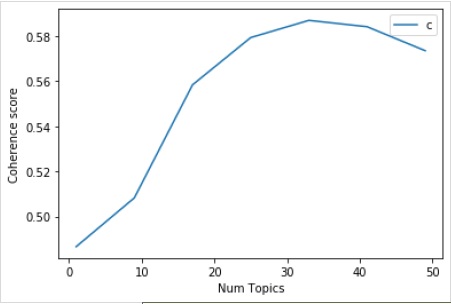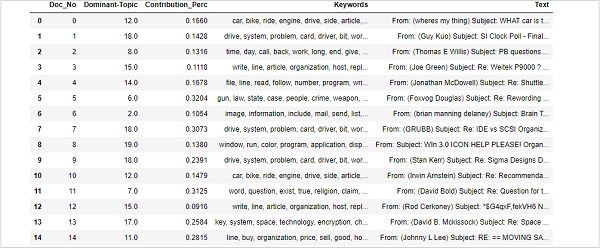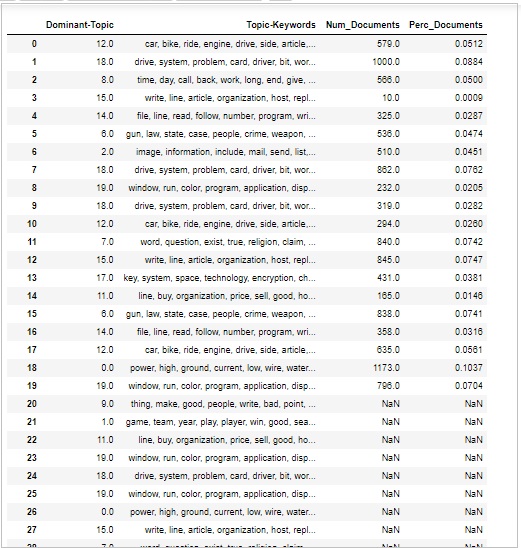Gensim - 文档和 LDA 模型
本章讨论 Gensim 中的文档和 LDA 模型。
寻找 LDA 的最佳主题数量
我们可以通过创建具有各种主题值的多个 LDA 模型来寻找 LDA 的最佳主题数量。在这些 LDA 中,我们可以选择一个具有最高一致性值的模型。
以下名为 coherence_values_computation() 的函数将训练多个 LDA 模型。它还将提供模型及其相应的一致性分数 −
def coherence_values_computation(dictionary, corpus, texts, limit, start=2, step=3):
coherence_values = []
model_list = []
for num_topics in range(start, limit, step):
model = gensim.models.wrappers.LdaMallet(
mallet_path, corpus=corpus, num_topics=num_topics, id2word=id2word
)
model_list.append(model)
coherencemodel = CoherenceModel(
model=model, texts=texts, dictionary=dictionary, coherence='c_v'
)
coherence_values.append(coherencemodel.get_coherence())
return model_list, coherence_values
现在借助以下代码,我们可以得到最佳主题数量,并借助图表显示这些主题数量 −
model_list, coherence_values = coherence_values_computation (
dictionary=id2word, corpus=corpus, texts=data_lemmatized,
start=1, limit=50, step=8
)
limit=50; start=1; step=8;
x = range(start, limit, step)
plt.plot(x, coherence_values)
plt.xlabel("Num Topics")
plt.ylabel("Coherence score")
plt.legend(("coherence_values"), loc='best')
plt.show()
输出

接下来,我们还可以打印各种主题的连贯性值,如下所示 −
for m, cv in zip(x, coherence_values):
print("Num Topics =", m, " is having Coherence Value of", round(cv, 4))
输出
Num Topics = 1 is having Coherence Value of 0.4866 Num Topics = 9 is having Coherence Value of 0.5083 Num Topics = 17 is having Coherence Value of 0.5584 Num Topics = 25 is having Coherence Value of 0.5793 Num Topics = 33 is having Coherence Value of 0.587 Num Topics = 41 is having Coherence Value of 0.5842 Num Topics = 49 is having Coherence Value of 0.5735
现在,问题来了,我们现在应该选择哪个模型?一个好的做法是,先选择连贯性值最高的模型,然后再进行讨好。因此,我们将选择上面列表中排名第 4 的包含 25 个主题的模型。
optimal_model = model_list[3] model_topics = optimal_model.show_topics(formatted=False) pprint(optimal_model.print_topics(num_words=10)) [ (0, '0.018*"power" + 0.011*"high" + 0.010*"ground" + 0.009*"current" + ' '0.008*"low" + 0.008*"wire" + 0.007*"water" + 0.007*"work" + 0.007*"design" ' '+ 0.007*"light"'), (1, '0.036*"game" + 0.029*"team" + 0.029*"year" + 0.028*"play" + 0.020*"player" ' '+ 0.019*"win" + 0.018*"good" + 0.013*"season" + 0.012*"run" + 0.011*"hit"'), (2, '0.020*"image" + 0.019*"information" + 0.017*"include" + 0.017*"mail" + ' '0.016*"send" + 0.015*"list" + 0.013*"post" + 0.012*"address" + ' '0.012*"internet" + 0.012*"system"'), (3, '0.986*"ax" + 0.002*"_" + 0.001*"tm" + 0.000*"part" + 0.000*"biz" + ' '0.000*"mb" + 0.000*"mbs" + 0.000*"pne" + 0.000*"end" + 0.000*"di"'), (4, '0.020*"make" + 0.014*"work" + 0.013*"money" + 0.013*"year" + 0.012*"people" ' '+ 0.011*"job" + 0.010*"group" + 0.009*"government" + 0.008*"support" + ' '0.008*"question"'), (5, '0.011*"study" + 0.011*"drug" + 0.009*"science" + 0.008*"food" + ' '0.008*"problem" + 0.008*"result" + 0.008*"effect" + 0.007*"doctor" + ' '0.007*"research" + 0.007*"patient"'), (6, '0.024*"gun" + 0.024*"law" + 0.019*"state" + 0.015*"case" + 0.013*"people" + ' '0.010*"crime" + 0.010*"weapon" + 0.010*"person" + 0.008*"firearm" + ' '0.008*"police"'), (7, '0.012*"word" + 0.011*"question" + 0.011*"exist" + 0.011*"true" + ' '0.010*"religion" + 0.010*"claim" + 0.008*"argument" + 0.008*"truth" + ' '0.008*"life" + 0.008*"faith"'), (8, '0.077*"time" + 0.029*"day" + 0.029*"call" + 0.025*"back" + 0.021*"work" + ' '0.019*"long" + 0.015*"end" + 0.015*"give" + 0.014*"year" + 0.014*"week"'), (9, '0.048*"thing" + 0.041*"make" + 0.038*"good" + 0.037*"people" + ' '0.028*"write" + 0.019*"bad" + 0.019*"point" + 0.018*"read" + 0.018*"post" + ' '0.016*"idea"'), (10, '0.022*"book" + 0.020*"_" + 0.013*"man" + 0.012*"people" + 0.011*"write" + ' '0.011*"find" + 0.010*"history" + 0.010*"armenian" + 0.009*"turkish" + ' '0.009*"number"'), (11, '0.064*"line" + 0.030*"buy" + 0.028*"organization" + 0.025*"price" + ' '0.025*"sell" + 0.023*"good" + 0.021*"host" + 0.018*"sale" + 0.017*"mail" + ' '0.016*"cost"'), (12, '0.041*"car" + 0.015*"bike" + 0.011*"ride" + 0.010*"engine" + 0.009*"drive" ' '+ 0.008*"side" + 0.008*"article" + 0.007*"turn" + 0.007*"front" + ' '0.007*"speed"'), (13, '0.018*"people" + 0.011*"attack" + 0.011*"state" + 0.011*"israeli" + ' '0.010*"war" + 0.010*"country" + 0.010*"government" + 0.009*"live" + ' '0.009*"give" + 0.009*"land"'), (14, '0.037*"file" + 0.026*"line" + 0.021*"read" + 0.019*"follow" + ' '0.018*"number" + 0.015*"program" + 0.014*"write" + 0.012*"entry" + ' '0.012*"give" + 0.011*"check"'), (15, '0.196*"write" + 0.172*"line" + 0.165*"article" + 0.117*"organization" + ' '0.086*"host" + 0.030*"reply" + 0.010*"university" + 0.008*"hear" + ' '0.007*"post" + 0.007*"news"'), (16, '0.021*"people" + 0.014*"happen" + 0.014*"child" + 0.012*"kill" + ' '0.011*"start" + 0.011*"live" + 0.010*"fire" + 0.010*"leave" + 0.009*"hear" ' '+ 0.009*"home"'), (17, '0.038*"key" + 0.018*"system" + 0.015*"space" + 0.015*"technology" + ' '0.014*"encryption" + 0.010*"chip" + 0.010*"bit" + 0.009*"launch" + ' '0.009*"public" + 0.009*"government"'), (18, '0.035*"drive" + 0.031*"system" + 0.027*"problem" + 0.027*"card" + ' '0.020*"driver" + 0.017*"bit" + 0.017*"work" + 0.016*"disk" + ' '0.014*"monitor" + 0.014*"machine"'), (19, '0.031*"window" + 0.020*"run" + 0.018*"color" + 0.018*"program" + ' '0.017*"application" + 0.016*"display" + 0.015*"set" + 0.015*"version" + ' '0.012*"screen" + 0.012*"problem"') ]
在句子中查找主导主题
在句子中查找主导主题是主题建模最有用的实际应用之一。它确定给定文档的主题。在这里,我们将找到在该特定文档中贡献百分比最高的主题编号。为了将信息汇总到表中,我们将创建一个名为 dominant_topics() −
的函数
def modest_topics(ldamodel=lda_model, corpus=corpus, texts=data):
sent_topics_df = pd.DataFrame()
接下来,我们将获取每个文档中的主要主题 −
for i, row in enumerate(ldamodel[corpus]):
row = sorted(row, key=lambda x: (x[1]), reverse=True)
接下来,我们将获取每个文档的主导主题、Perc 贡献和关键字 −
for j, (topic_num, prop_topic) in enumerate(row):
if j == 0: # => dominant topic
wp = ldamodel.show_topic(topic_num)
topic_keywords = ", ".join([word for word, prop in wp])
sent_topics_df = sent_topics_df.append(
pd.Series([int(topic_num), round(prop_topic,4), topic_keywords]), ignore_index=True
)
else:
break
sent_topics_df.columns = ['Dominant_Topic', 'Perc_Contribution', 'Topic_Keywords']
借助以下代码,我们将原始文本添加到输出的末尾 −
contents = pd.Series(texts) sent_topics_df = pd.concat([sent_topics_df, contents], axis=1) return(sent_topics_df) df_topic_sents_keywords = dominant_topics( ldamodel=optimal_model, corpus=corpus, texts=data )
现在,对句子中的主题进行如下格式化 −
df_dominant_topic = df_topic_sents_keywords.reset_index() df_dominant_topic.columns = [ 'Document_No', 'Dominant_Topic', 'Topic_Perc_Contrib', 'Keywords', 'Text' ]
最后,我们可以按如下方式显示主导主题 −
df_dominant_topic.head(15)

查找最具代表性的文档
为了更多地了解该主题,我们还可以找到给定主题贡献最大的文档。我们可以通过阅读该特定文档来推断该主题。
sent_topics_sorteddf_mallet = pd.DataFrame()
sent_topics_outdf_grpd = df_topic_sents_keywords.groupby('Dominant_Topic')
for i, grp in sent_topics_outdf_grpd:
sent_topics_sorteddf_mallet = pd.concat([sent_topics_sorteddf_mallet,
grp.sort_values(['Perc_Contribution'], ascending=[0]).head(1)], axis=0)
sent_topics_sorteddf_mallet.reset_index(drop=True, inplace=True)
sent_topics_sorteddf_mallet.columns = [
'Topic_Number', "Contribution_Perc", "Keywords", "Text"
]
sent_topics_sorteddf_mallet.head()
输出

主题的数量和分布
有时我们还想判断文档中讨论主题的广泛程度。为此,我们需要了解文档中主题的数量和分布情况。
首先计算每个主题的文档数量,如下所示 −
topic_counts = df_topic_sents_keywords['Dominant_Topic'].value_counts()
接下来,计算每个主题的文档百分比,如下所示 −;
topic_contribution = round(topic_counts/topic_counts.sum(), 4)
现在找到主题数量和关键字,如下所示 −
topic_num_keywords = df_topic_sents_keywords[['Dominant_Topic', 'Topic_Keywords']]
现在,按列连接,如下所示 −
df_dominant_topics = pd.concat(
[topic_num_keywords, topic_counts, topic_contribution], axis=1
)
接下来,我们将更改列名称,如下所示 −
df_dominant_topics.columns = [ 'Dominant-Topic', 'Topic-Keywords', 'Num_Documents', 'Perc_Documents' ] df_dominant_topics
输出



